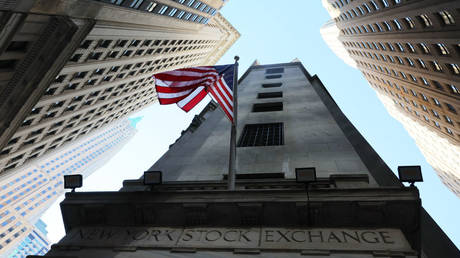"Apocalypse Now or Later?" Exploring the Implications of the Stock Market Collapse and the Fed's Biggest Concerns
The American economy has become overly reliant on financialization, leaving it vulnerable to any prolonged decline in asset prices.

On Monday, Japan's Nikkei 225 saw its largest single-day fall since the 1987 'Black Monday', dropping over 12%. Similarly, the Dow Jones Industrial Average has fallen by about 1,000 points, and the Nasdaq has declined nearly 4%, underscoring a widespread market downturn.
The downturn was sparked by a series of factors, including a weak US jobs report last Friday, which heightened fears of a looming recession. Additionally, the decline in the AI sector, previously buoyed by high levels of leverage and enthusiasm, has significantly impacted tech stocks.
A key element in this crisis has been the disruption of the dollar-yen carry trade. This financial strategy involves borrowing yen at low interest rates to invest in higher-yielding US assets. However, the Bank of Japan’s recent rate increase on July 31, along with indications of further hikes, prompted a large-scale unwinding of these positions, exacerbating the market's instability.
The uncertainty of predicting market movements makes it challenging to forecast the short-term outlook. While some investors attempt to buy during these downturns, others remain cautious given the volatility. Analysts have mixed opinions, with some deeming the current panic as exaggerated and anticipating market stabilization soon.
The market's current state is more reflective of an unwinding of overextended positions rather than a reaction to economic disruptions. Many investors had leveraged purchases in tech stocks, financed by low-cost Japanese yen loans. The resulting forced selling to cover margin calls has intensified the sell-off.
Looking ahead, the focus lies on how perceptions of the Federal Reserve's actions might evolve. After maintaining interest rates in July, there’s an anticipation of a possible rate cut in September to counteract inflation from post-pandemic hikes. The market turmoil has accelerated discussions about potential cuts, with futures recently indicating a significant expected decrease in rates for the upcoming Federal Reserve meetings.
The market's drastic reactions also point to the Federal Reserve's implicit role in ensuring market stability, beyond its official mandates of price stability and employment. This role, informally known as the 'Fed put', suggests the Fed will intervene to support the market during downturns, despite official denials of such a policy.
The reliance on the Federal Reserve’s intervention highlights the profound financialization and leverage within the US economy. A significant portion of the US economy is intricately linked to asset prices, making sustained market downturns potentially devastating. This connection even extends to the government’s fiscal health, as seen in the recent anomaly where economic and income growth did not translate into higher tax revenues due to a drop in capital gains.
These dynamics illustrate the complexities and dependencies that define modern financial markets and the broader economy. The upcoming actions by the Federal Reserve and their implications will be crucial, as market stability remains a central concern for policymakers and investors alike.As the Federal Reserve navigates this precarious landscape, its decisions regarding interest rates will be closely monitored by investors who are acutely aware of the stakes involved. The effectiveness of the Fed’s communication will be critical during this tumultuous period. If the Fed can convey confidence while signaling potential support for the markets, it may help to stabilize sentiment and prevent further panic.
Moreover, there remains a broader systemic issue intertwined with the Fed’s actions: the growing disconnect between market performance and real economic health. While financial markets can experience volatility driven by speculative behavior, the underlying indicators of economic stability—such as wage growth, employment figures, and consumer confidence—present a more complicated picture. This divergence can lead to uncertainty among investors about the sustainability of asset price increases, especially if rates are cut to support markets while inflation remains a concern.
The implications of a financialized economy, where asset prices can influence everything from fiscal policy to social equity, must also not be underestimated. The wealth effect—from rising equity markets enhancing consumer spending—has long been a pillar of economic growth in the U.S. When markets thrive, the affluent feel richer and spend more, but this can exacerbate the divide between them and those who do not benefit from investment gains.
This stratification is also evident in the responses to inflationary pressures. Wealthier individuals, often holding significant investments in stocks and other assets, can adjust more readily to inflation thanks to their financial buffer. In contrast, those on fixed incomes or relying solely on wages face eroded purchasing power, further entrenching economic inequality. The correlation between stock market performance and social stability cannot be ignored, as escalating asset prices contribute to the prosperity of a relatively small segment of the population.
Looking ahead, the Federal Reserve’s commitment to fostering a stable market environment may lead to challenging trade-offs concerning inflation control and economic growth. The expectation of continued monetary easing could drive asset prices up in the short term, and yet the long-term ramifications of such policies might exacerbate existing economic distortions. Furthermore, should inflationary pressures persist, the Fed may find itself in a position where restoring balance necessitates raising interest rates substantially, potentially leading to another sharp market correction.
The Fed's historical penchant for intervening amid crises and demonstrating its willingness to support financial markets is likely to persist as long as structural vulnerabilities underpinning the economy remain unaddressed. The institution may still act as a safety net for markets, staving off deeper corrections for the near term while broader economic reforms remain elusive.
Ultimately, investors and policymakers alike will need to closely observe not only the immediate responses from the Federal Reserve but also the underlying changes in the financial ecosystem. As long as markets are perceived to be interconnected with economic stability, the Fed's actions will be viewed through the lens of maintaining that stability—regardless of potential repercussions on inflation or long-term economic health.
The future landscape will depend heavily on how the Federal Reserve adapts to these evolving dynamics while balancing its dual mandates of managing inflation and supporting economic growth. The path forward is fraught with uncertainty, but as history demonstrates, the interplay between financial markets and economic policy will continue to shape the realities of the United States economy for years to come.
James del Carmen for TROIB News
Find more stories on Business, Economy and Finance in TROIB business











